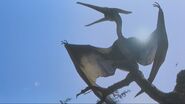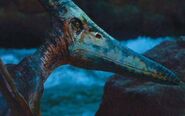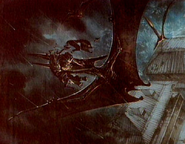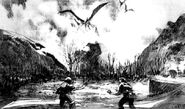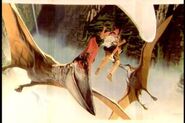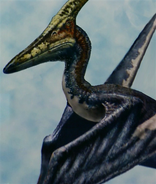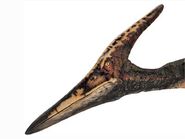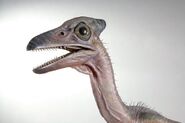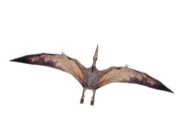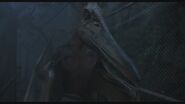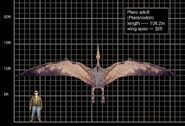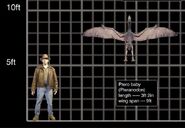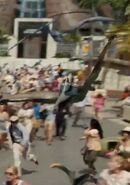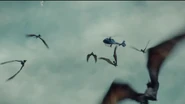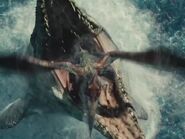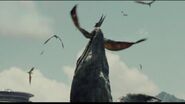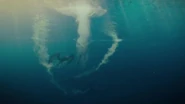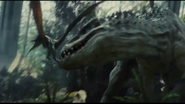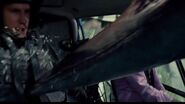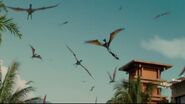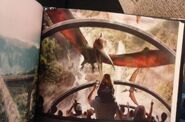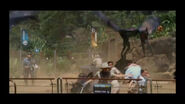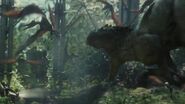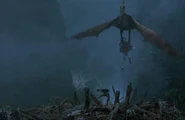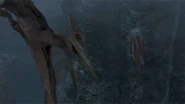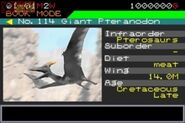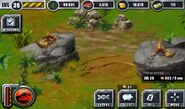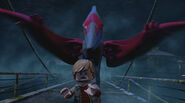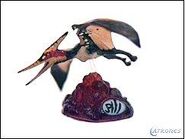(Editing a gallery) Tag: gallery |
No edit summary Tag: sourceedit |
||
| Line 1: | Line 1: | ||
{{Spoiler}} |
{{Spoiler}} |
||
{{Dinosaur |
{{Dinosaur |
||
| + | |name = [[File:pteranodon.png]] |
||
|image = Terry.png |
|image = Terry.png |
||
|meaning = Toothless wing |
|meaning = Toothless wing |
||
Revision as of 21:45, 3 September 2015

|
"'Ooh, ah,' that's how it always starts. But then later there's running and screaming."
This page contains spoilers from an upcoming, or newly released installment of the Jurassic Park franchise. If you don't want spoilers, leave the page! |
Pteranodon is a massive flying reptile. When it spread its wings, it could reach from the front to the back of a school bus. Just imagine something that big flying around. It did not have feathers, but rather had a basal type of integument along the same lineage that feathers evolved upon called pycnofibers. Pycnofibers were very hair-like in appearance and, like hair, were made of keratin.
Members of the Pterosaur order lived through much of the Mesozoic, some species of Pterosaurs with wingspans close to 11 m (36 feet). Pteranodon males had a wing span of 5 metres (18 feet), while females had a wing span of 3 meters (12 feet). Making it one of the largest Pterosaurs found.
Pteranodon, as you can tell by the translation of its name, had no teeth, something portrayed (it having teeth) in the movie. It probably used the long crest on the back of its head to help it steer while flying. The movement is still some debate about whether these reptiles could actually fly or if they were primarily gliders, but the consensus seems to be that they could take off with little or no wind.
Their diet was fish and scavenged remains of dead marine animals. Quite a few Pteranodon skeletons have been found in Kansas in the central part of the U.S. This would have been the shore of a shallow sea when these creatures were alive, supporting the theory that they were fish eaters.[2]
| Wikipedia has a more detailed and comprehensive article on Pteranodon |
Story
Creation
Pteranodon was successfully recreated by InGen in the lab on Isla Sorna where they were fed and parented in captivity being raised in the Isla Sorna Aviary.
There were three variations of the cloned Pteranodon that both had abnormal features that their original counterpart lacked. However, there were common characteristics the clones such as a lack of pycnofibres on their bodies, which all pterosaurs had, was adapted to different regions than the original, the wing membrane being like that of a bat, and the ability to use their hind legs for grasping. The geneticists probably removed sexual dimorphism from the recreations because they wanted all the clones to born female and Pteranodon's famous crest belonged only to males in the genus.
The variation seen at the end of The Lost World: Jurassic Park had many characteristics of birds that can be seen in its bipedal gait, neck posture, and the curved beak it has that is akin to some genera of seabirds. Their bodies were black with the wing membrane being tan and the back of the wings being dark brown. Their heads were dark green with a yellow beak, much like a male Mallard.
The second variation that was the most commonly encountered and retained the quadrupedal gait of the pterosaurs, but it had teeth lining its beak, lacked sexual dimorphism, great strength, and feet like a bird of prey as well as having a lifestyle just like one. They laid an estimate of six eggs and their young was able to fly at an early age, but it seemed to be limited so the juveniles could not hunt for themselves, requiring an adult to fetch them their food. This variation of Pteranodon had a color scheme consisting of tan and brown, but also had splotches of black on the tips of its wings and on its beak.
The third variation was an actual species that existed before the cloning process named Pteranodon sternbergi, which has since been classified as a seperate genus Geosternbergia.
Once the pterosaurs were old enough they would be transported to the Jurassic Park on Isla Nublar to live inside the Isla Nublar Aviary.[3] However, they were not planned to be seen by the public eye until phase two of the park occurred. The variation brought to the island was a mix between the two variations.
Isla Nublar Incident (1993)
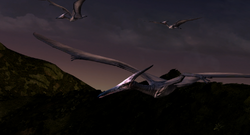
A flock of Pteranodon roaming wild during the Isla Nublar Incident of 1993.
When Dennis Nedry deactivated most of Jurassic Park's security systems so he could steal InGen's dinosaur embryos for Biosyn he allowed nearly all of the park's terrestrial fauna, including Pteranodon, to roam freely on the island.
Unlike the other animals that were running wild on Isla Nublar during the incident, the Pteranodons seemed to have caused very little havoc. The only notable chaotic action know from the Pteranodons on the incident was from a lone individual who attacked the helicopter of Daniel Cafaro, Billy Yoder, and Oscar Morales, mercenaries hired by InGen to escort any remaining humans off of the island. Its strike damaged the helicopter and knocked its pilot, Daniel Cafaro, unconscious. But no one inside the aircraft were killed thanks to Billy Yoder who quickly reacted to the attack by turning on its autopilot and taking control of the helicopter, giving it a safe landing.
It is unknown what happened to the Pteranodon populations on Isla Nublar after the Isla Nublar Incident of 1993.
Wild on Isla Sorna
When Hurricane Clarissa stuck Isla Sorna the InGen personal fled the island. Some of the Pteranodons were either freed by the workers or broke out of their cages themselves, but a population of Pteranodon was still kept inside the Isla Sorna Aviary. The bird-like variation took residence in the southeast while the variation with teeth were only known to the southeast with an isolated population still living in the Aviary. The pterosaur was the largest flying animal on Isla Sorna currently known.
The cloned pterosaurs combatted the Lysine contingency by eating animals (such as some types of fish and even territorial vertebrates) rich with Lysine.
By 2001, there were four Pteranodon adults and six juveniles living in the Isla Sorna Aviary. At some point, the family encountered a human as evident by the human remains in the nest in Jurassic Park III. It is unknown who this person was and if he/she was even alive when the Pteranodons found him/her, but it could have been a parasailer from the Dino-Soar, an illegal business that lets customers parasail around Isla Sorna, which doesn't allow human visitors since 1997.
Isla Sorna Incident (2001)
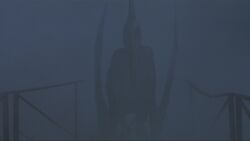
A Pteranodon emerging from the fog on the Isla Sorna Aviary bridge.
The Pteranodon family living in the Isla Sorna Aviary had a brief, but major skirmish with the surviving humans involved in the incident. One of the adults detected the human visitors' presence in its enclosure as they crossed the bridge that connects the observatory to the Isla Sorna Aviary so they could get in the barge below. The adult pterosaur decided to land on the bridge when it was Eric Kirby's time to cross. Eric let out a scream of terror just before breaking into a sprint when the Pteranodon emerged from the thick fog that was surrounding the back of the laboratory to the front of the aviary.
The large pterosaur responded by snatching Eric Kirby and flying off as his group were racing towards the situation. The pterosaur carried the young human to a rock platform near its nest that was filled with baby Pteranodons chirping out of hunger. With the hungry babies setting their sights on him, Eric threw a human skull that laid on the ledge that he was on in an attempt to detour them. But his throw was too high to hit any of the juvenile pterosaurs so he decided to retaliate by jump to a nearby platform with the juveniles in pursuit of him.
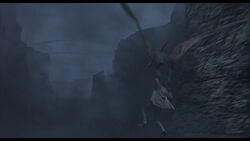
A Pteranodon with Eric Kirby in its clutches.
However, when Eric landed he lost his footing, allowed the juvenile Pteranodons to swarm around. Kirby kicked and screamed as they attempted to consume him, but there was hope for because he heard Billy Brennan calling for him as he bravely descended towards the nesting area to save the boy using the recovered paraglider of the now deceased Ben Hildebrand. The baby Pteranodons bit tightly on Eric Kirby's jacket, focused on the appeal rather than their main target. Eric used this to his advantage by giving his jacket over to the hungry Pteranodons and leaping to another platform behind him afterward. Though as soon as he reached his destination he found there was nowhere else to flee to, allowing the juvenile pterosaurs to continue attacking him.
Thankfully for Eric Kirby, Billy Brennan was coming close to the stone platform that he was on, wanting Eric to jump to him. Eric was eager to escape his attackers so he swiped the Pteranodons off of him and he successfully clinged to Billy soon afterward. The Pteranodon juveniles ceased their pursuit as Eric Kirby drifted away with his rescuer, but there was one that continued the chase and managed to grasp itself onto Eric's back. However, the pterosaur's grip was not very firm and it soon fell to death as Billy made sharp turns as he glided. Despite being rescued by Billy Brennan, the boy was not safe from danger. As the two paraglided three adult Pteranodons followed them with one tearing their parachute minorly. This attack made Billy demand Eric to let go of him and to jump safely into the water below.
Concurrent to the events mentioned above, Dr. Alan Grant and Amanda and Paul Kirby were racing through the aviary's walkway trying to reach Eric. But they were put to a halt when they reached a section of the walkway that was completely missing. This gave an adult Pteranodon the chance to strike them. It tried getting through the open passageway, but its large wingspan and head crest wouldn't allow it to fit through. So it decided to fly up and land on the top of one of the sections of the passageway that was slightly damaged and slide its beak through hoping to bite one of the fleeing humans. Because of its weight, the roof of the passage collapsed, getting the Pteranodon inside the walkway. Now closer to the humans, the Pteranodon adult attempted to bite Dr. Alan Grant who was the human closest to it, but its attack was denied when he kicked the giant pterosaur in the neck. As the flying reptile cornered its prey to the end of the hallway, the section they were in collapsed from the added weight of the pterosaur, plunging both the humans and the Pteranodon into the water below. The pterosaur quickly reached by emerging to prepare itself for flight, but was pushed back into the river by the falling segment it unwillingly helped detach.
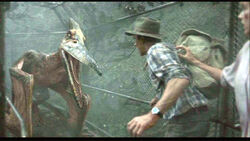
Dr. Alan Grant and Amanda and Paul Kirby cornered by a pterosaur.
As Billy Brennan glided away from any of the airborne reptiles chasing him, his paraglider became snagged on a bulging nearby rock face. With their prey in a weak position, two Pteranodons began to circle around him like buzzards, preparing to strike. Billy freed himself by removing his harness and fell into the riverbank below, but he was not free from the sight of the Pterosaurs. Dr. Alan Grant and Paul Kirby, who had just reached dry land, reunited with Eric Kirby, and were watching Billy from afar, rushed to rescue him. Once they reached Billy's position, a Pteranodon snatched him, but it lost grip of its prey seconds after grabbing him, only for a second Pteranodon to pin him to the rock bed of the river. Though, like the previous attack, Brennan broke free his attackers grasp. As he was attacked by the pterosaurs, Billy demanded to the two group members of his not to try saving him. After one final plea, the two pterosaurs that had pursued Billy relentlessly assaulted him at the same time and proceeded to viciously maul him as his body drifted down the river. However, Brennan somehow lived from his lacerations the Pteranodons gave him and he was later rescued by the Marines at the end of the incident.
A third Pteranodon began to chase Dr. Alan Grant and Paul Kirby has Billy was mauled. But when it tried to snatch one of the humans they both took a dive into the deep waters of the river where they swam to the barge and the rest of their group. The Pteranodon followed in pursuit but was blocked by one of the metal walls of the Aviary. While the two men went to save Billy, Eric and Amanda Kirby unlocked the door to the Isla Sorna Aviary to escape it. After the two unlocked the door, Amanda soon relocked it, though unknown to her it soon reverted back when she and the other survivors rushed to get to the boat.
The three Pteranodon adults escaped their enclosure after the humans had left. For some reason they abounded their young, this could have been because they didn't know how expansive the world was outside of the Aviary or they thought the fourth Pteranodon would take care of the juveniles, which seems unlikely after the section of the walkway fell on it. The survivors and the Marines/Navy who had rescued them saw the three pterosaurs as they flew away from Isla Sorna. When asked by Dr. Grant why the flying reptiles were leaving their home, Dr. Grant suggested that they were looking for new nesting grounds. The survivors hardly showed concern for the escaped pterosaurs, being more focused on the joy of being rescued.
The escaped Pteranodons traveled a long distance, reaching Canada before they "cleaned up" by Vic Hoskins and his InGen Security Division team. How the situation was handled impressed Simon Masrani who had bought out InGen and had plans to make his own dinosaur park. He decided to appoint Vic to a high position in the InGen Security Divison with the hopes that he would reinvent the security firm.[4]
Jurassic World
Pteranodon was recreated by InGen a second time for Masrani Global Corporation's new dinosaur park Jurassic World. These new clones were more close to the original animal, lacking teeth and having bat-like wing membrane that their cloned precursors had. However, they still could use their feet to grab objects like the clones in the third and were still highly aggressive. Despite their aggression, they seemed to be comfortable with living alongside the smaller Dimorphodon inside the Jurassic World Aviary.
Isla Nublar Incident (2015)
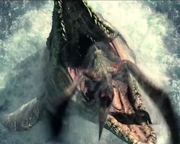
Zara and a Pteranadon getting devoured by the Mosasaurus.
When the helicopter chasing the hybrid Indominus rex entered the aviary, a Pteranodon attacked it, causing the helicopter to spin out of control and smash into the walls of the enclosure. This allowed the residents of the aviary to escape.
A mixed flock of Pteranodon and Dimorphodon flew into the Main Street of the park and started to attack the human visitors in the area. One notable Pteranodon snatched Jurassic World employee Zara, and dropped her into the Jurassic World Lagoon where the Mosasaurus lived. After dropping its victim, the Mosasaurus inside the lagoon saw the Pteranodon flying over her territory and proceeded to consume the large pterosaur whole, killing Zara in the process, who was in the grip of the Pteranodon.[5] Another mixed flock was present in the Gentle Giants Petting Zoo where they also attacked the also attacked the people there as well as the juvenile animals.
Gallery
Trivia
- A humorous incident occurred at Jurassic World when a Pteranodon stole a man's hat.[6]
- Pteranodon was featured on the of the Novel bundle despite making no appearance in the novels whatsoever.
Jurassic Park Adventures: Survivor
During his stay on Isla Sorna, Eric Kirby witnessed a Tyrannosaurus rex kill a Pteranodon.
Jurassic Park Adventures: Flyers

In the novel Flyers, the flock of 7 Pteranodons that is seen at the end of Jurassic Park III has reached Universal Studios in Florida and starts to terrorize the tourists. They drive all tourists into the central Lagoon to eat them after sunset.
All creatures have a name:
- Elder: the patriarch of the group
- Flood: Elder's daughter. Her markings were blue like the waves and gray like the rocky shore.
- Fire: Flood's mate, a strong and powerful creature. With his crimson markings, he looks like the fiery dawn.
- Goldie: most troublesome child of Fire and Flood. Has a bright golden tinge on his wings.
- Lightning: another young. His wings bare two silver streaks like lightning.
- Spike: young.
- Trip: young.
Jurassic Park (arcade game)
Pteranodon is encountered in all areas of the arcade game Jurassic Park.
Jurassic Park (SEGA Genesis Game)
Pteranodon is an enemy in the SEGA Genesis port of Jurassic Park.
Jurassic Park 2: The Chaos Continues
In Jurassic Park 2: The Chaos Continues, Pteranodon live in rocky cliffs and pits. They do not attack the player, but can block a necessary path.
The Lost World: Jurassic Park (arcade game)
Pteranodon is one of the enemies in the arcade game The Lost World: Jurassic Park.
The Lost World: Jurassic Park (SEGA Genesis Game)
The pterosaur is an enemy in the SEGA Genesis game The Lost World: Jurassic Park.
Jurassic Park: Trespasser
Pteranodon appears in Jurassic Park: Trespasser on the mural in the operations center.
Jurassic Park III (arcade game)
It is encountered in Chapter 3 of Jurassic Park III arcade game. There are two variations in this game, one that is seen in the Jurassic Park III film, and another that is the boss of the stage that has darker skin.
Jurassic Park III: Danger Zone!
Pteranodon is one animal you need to get DNA from in Jurassic Park III: Danger Zone!.
Jurassic Park III: Island Attack
Pteranodon is an enemy in Jurassic Park III: Island Attack.
Jurassic Park III: The DNA Factor
Pteranodon is an enemy in Jurassic Park III: The DNA Factor.
Jurassic Park: Survival
Pteranodon would have appeared in the planned game Jurassic Park: Survival.
Jurassic Park III: Park Builder
Pteranodon can be created from paleo-DNA in the game Jurassic Park III: Park Builder. A larger variant called "Giant Pteranodon" can also be created, and it may be simply a male Pteranodon, as it looks similar to what the males were planned to look like.
Jurassic Park III: Dino Defender
It is one of the carnivores that is featured in the game Jurassic Park III: Dino Defender.
Jurassic Park: Dinosaur Battles
In Jurassic Park Dinosaur Battles, a few Pteranodons appeared, but they are unplayable.
Jurassic Park: Explorer
Pteranodon is one is the creatures that can be captured in the game Jurassic Park: Explorer. When a Pteranodon is captured this video will be shown. It also appears in a short clip flying above a river.
Jurassic Park: Builder
'see Pteranodon/Builder
- Pteranodon is one of the available creatures in the IOS application, Jurassic Park: Builder.
Jurassic World: The Game
Pteranodon is seen in Jurassic World: The Game as a Legendary pterosaur. Once you hatch your first Pteranodon, it costs 2,910 DNA to buy another one.
LEGO Jurassic World
The Pteranodon appears in LEGO Jurassic World and did many of the same things that Pteranodon did in The Lost World: Jurassic Park, Jurassic Park III and Jurassic World. Like the other dinosaurs in the game, the pterosaur sometimes participates in humorous antics, due to the game's comical nature.
Comic books

Pteranodon from Topps Jurassic Park comics. (Image courtesy of Jurassic Park Legacy)
Two Pteranodons attack the plane of Lex Murphy in Jurassic Park: Redemption I as she is flying over Costa Rica. Two armed aircraft try to drive the creatures away.
Toys lines
Pteranodon figures have appeared in many toy lines. The most classic is the blue/gray figure from the Kenner Series 1. This figure was so well known that it appeared in Toy Story. The figure was re-painted for later reappearances in Jurassic Park: Dinosaurs and The Lost World Series 1. Another figure was released for the Jurassic Park III toyline.
Other figures have appeared in:
- Die-Cast: Jurassic Park
- The Lost World Series 1
- Jurassic Park III (Hasbro)
- Jurassic Park III (Kaiyodo) (prototype only)
- CamoXtreme
- Jurassic Park: Dinosaurs
- Jurassic Park: Dinosaurs 2
- Jurassic Park: Dinosaurs 3
An animatronic Pteranodon is shown in the T. rex encounter attraction of the Jurassic Park Institute Tour.
Behind the scenes
In the film canon, Pteranodon was ultimately chosen instead of the novels' Cearadactylus, probably because of its larger size, more spectacular/impressive appearance and massive popularity with audiences.
Steven Spielberg did not want to have the Cearadactylus in the first Jurassic Park film, as he previously felt that the aviary scene exactly described in the novel would have been too expensive and complicated to recreate, resulting in this scene being among the first to be automatically scrapped from the filming schedule.
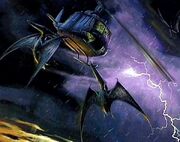
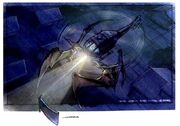
Later in The Lost World: Jurassic Park, Spielberg wanted to show an action sequence called Air Attack which has a team of gatherers running away from a pack of Velociraptors and leaping off a cliff with hang gliders from their backpacks. However, while they are safely flying in the air they are attacked by Pteranodons or Geosternbergia. Once again, the idea was ultimately abandoned (although conceptual art for both animals, as well as maquettes for Pteranodon, exist for that film). Another action sequence was developed but was also cut, where Pteranodons were attacking the rescue chopper.
In the script for Jurassic Park III the Dino-Soar crew are killed by Pteranodons. This could be an explanation for the human bones inside the Isla Sorna Aviary.
Trevor Morgan, the actor who played Eric Kirby, considered the scene where the Pteranodon snatches his character to be his favorite scene in Jurassic Park III.[7]
Much like Spinosaurus, Pteranodon was to be an animal that was not listed on InGen's List in a revision of the Jurassic Park III script.[8] This would have been contradictory to what was shown in The Lost World: Jurassic Park when Pteranodon (Geosterbergia) was seen on the fact sheets given to the InGen Hunters and as one of the screensavers in the Gatherers' RV.
Vocalizations
The screech a Pteranodon makes at the end of the The Lost World: Jurassic Park was made by Gary Rydstom slowing down the sound of him taking out tooth floss from his box.
For Jurassic Park III, large bird sounds (including giant petrels) were used for the Pteranodons vocalizations. Voice actor Frank Welker also lent his voice to producing some their sounds. According to an interview of Sam Neill, the actor who played Dr. Alan Grant in the films, there was going to be a scene where the pterosaurs encountered the Velociraptors, but it never appeared in the final film. One of Jurassic Park III's alternate endings was one of the escaped Pteranodons attacking the rescue chopper of the survivors. This concept seems to have been reincorporated in the Jurassic Park: The Game scenario "Chopper Down!".
References
- ↑ 1.0 1.1 1.2 Holtz, T. R., Brett-Surman, M. (2001). Dinosaur Field Guide, New York, NY: Random House, Inc.
- ↑ Dinopedia on the JPI site
- ↑ InGen Field Guide, Page 9
- ↑ www.masraniglobal.com - InGen Security Retrieved from http://www.masraniglobal.com/about/divisions/ingen/security/index.html
- ↑ http://orig05.deviantart.net/c618/f/2015/140/4/1/zarastruggling_by_kyle_dove-d8u45b5.gif
- ↑ JurassicWorld.com - Standard Package Retrieved from http://www.jurassicworld.com/tickets/standard/
- ↑ Jurassic Park III website
- ↑ YouTube - Art of JP3
| Compsognathus • Gallimimus • Mamenchisaurus • Pachycephalosaurus • Parasaurolophus • Pteranodon • Stegosaurus • Triceratops • Tyrannosaurus rex • Velociraptor |
| Ankylosaurus • Brachiosaurus • Ceratosaurus • Compsognathus • Corythosaurus • Parasaurolophus • Pteranodon • Spinosaurus • Stegosaurus • Triceratops • Tyrannosaurus rex • Velociraptor |
| Ankylosaurus • Apatosaurus • Dimorphodon • Gallimimus • Indominus rex • Mosasaurus • Pachycephalosaurus • Parasaurolophus • Pteranodon • Stegosaurus • Triceratops • Tyrannosaurus rex • Velociraptor |


